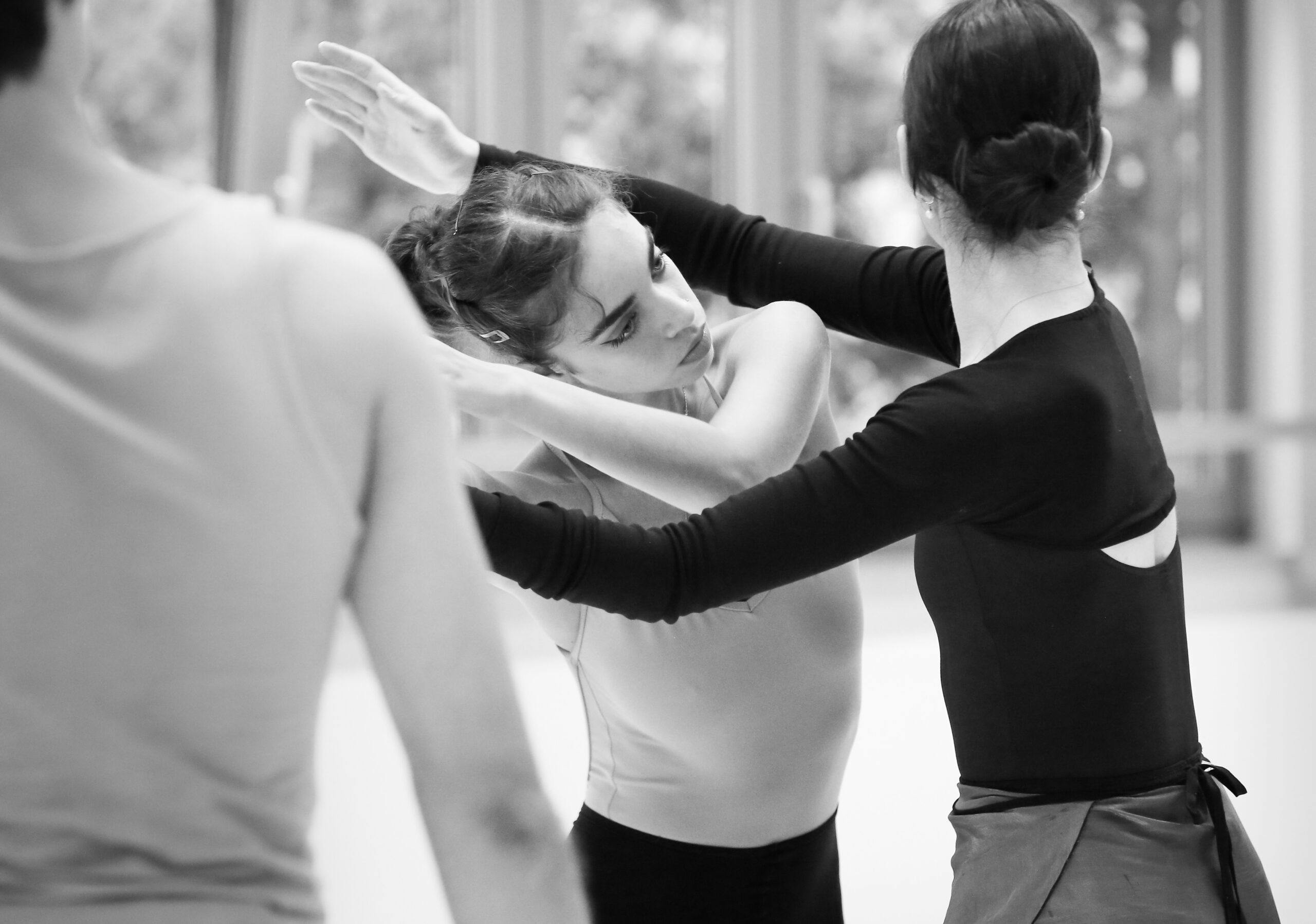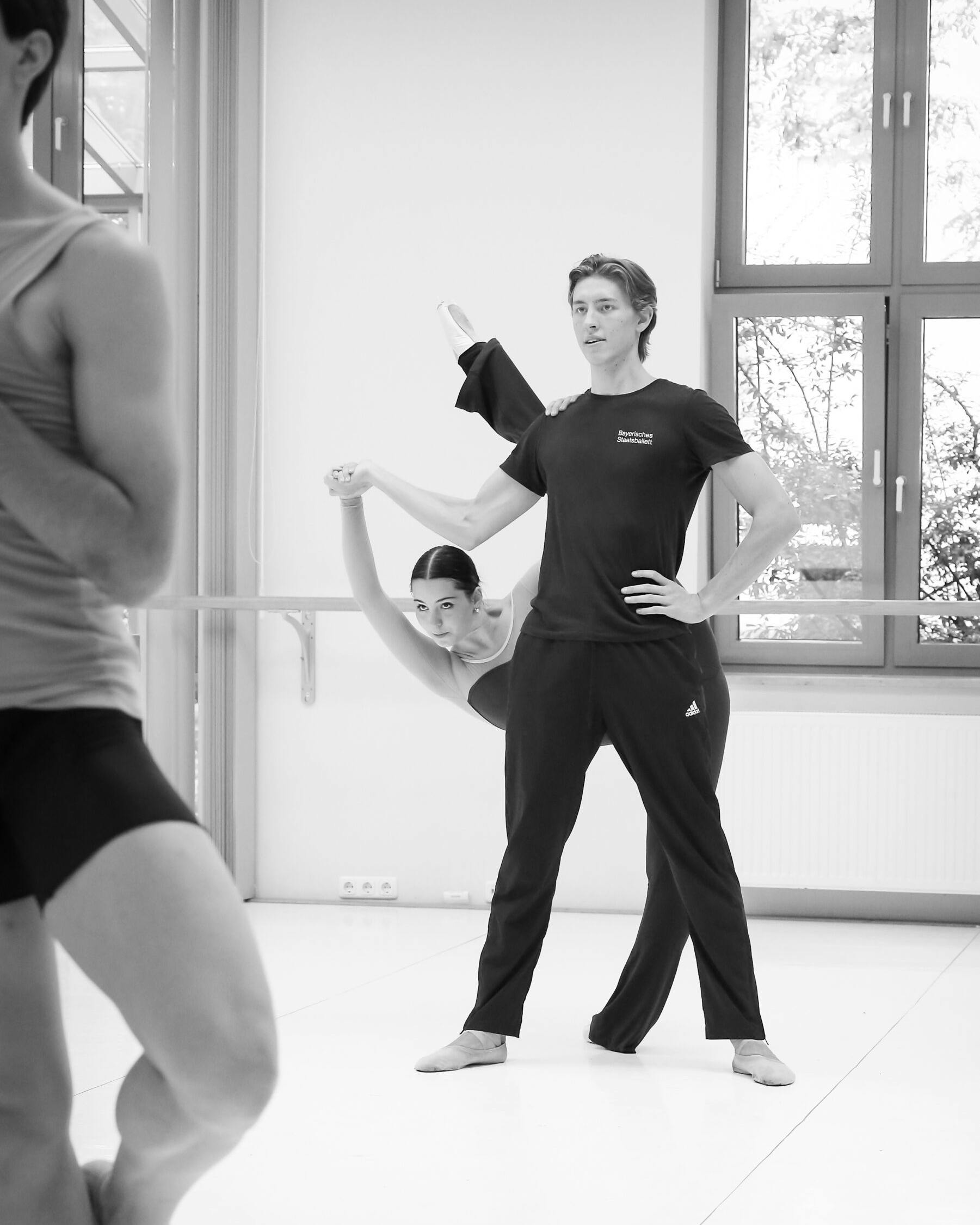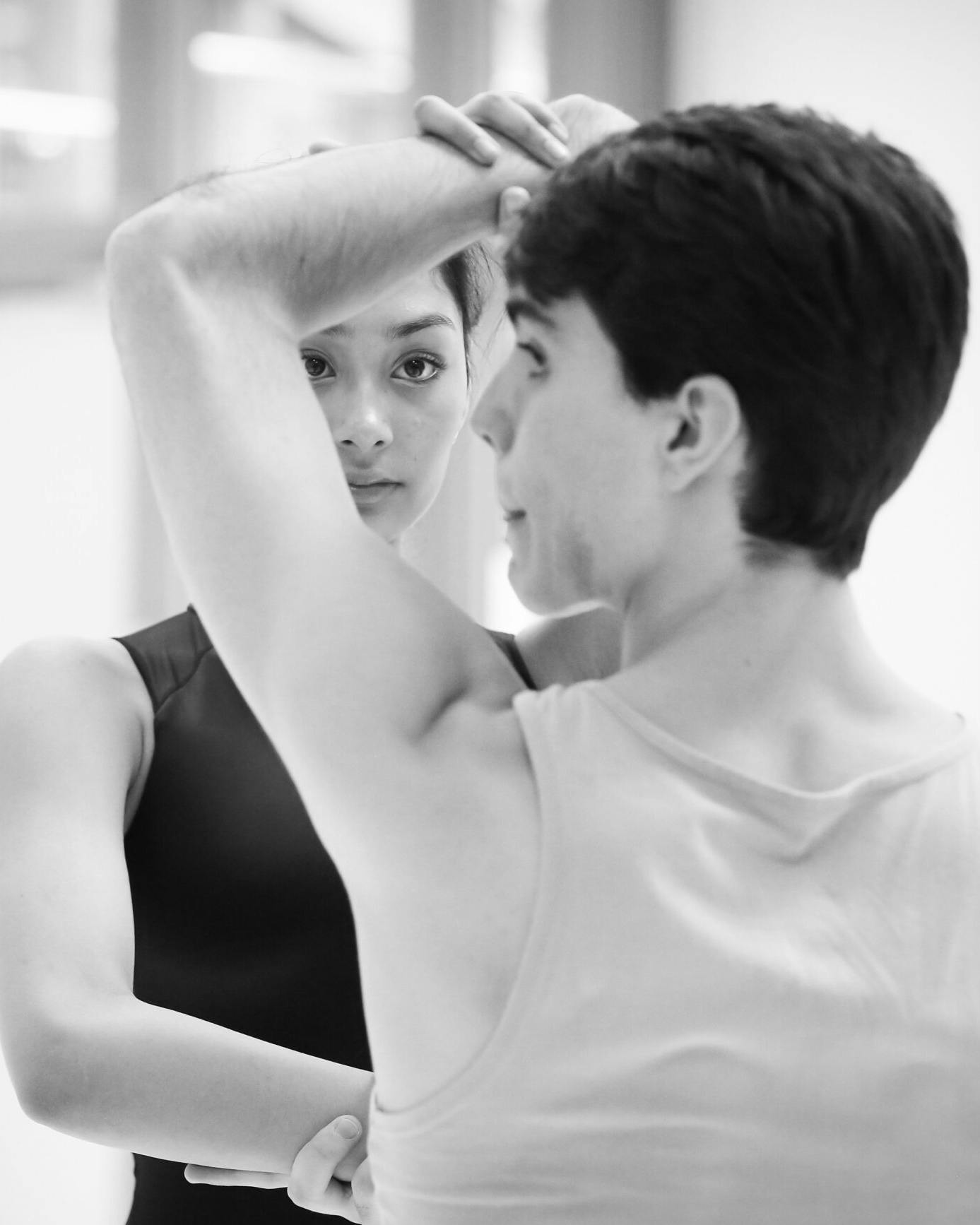Interview
Connected to dance heritage – two choreographers explain...
by Deike Wilhelm
The Bavarian Junior Ballet Munich will be presenting two new works at this year's Autumn Matinés. Both creations were created by choreographers with close ties to the Heinz Bosl Foundation and the Bavarian Junior Ballet. Kammertanzer Norbert Graf is a deputy chairman of the Foundation, a former "Boseleaner" and has already created five works for the Juniors. Simon Adamson-De Luca, 19 years old, is currently a dancer with the Bavarian Junior Ballet Munich and is creating a new work with his colleagues. With both of these new commissions, the Heinz Bosl Foundation remains true to its repertoire policy for the junior company by engaging established choreographers and young artists to give the young artists as broad an experience as possible.

A conversation with both choreographers …
Deike Wilhelm: What are the themes of your new works?
Norbert Graf: «Stück im alten Stil» («Piece in an old style») is a homage and a reverence to the choreographers who have influenced me the most in my physical dance and physical means. It is my most personal creation to date because it draws completely from what emerges from within.
Deike Wilhelm: Which choreographic masters have sculpted you as a dancer?
Norbert Graf: Actually, I am less interested in individual choreographers than in their respective movement and definitions of movement qualities. However, if I had to name three choreographers who have shaped me as a dancer, I would mention Ohad Naharin, Mats Ek and William Forsythe. When I was training to be a dancer we didn’t have modern classes and so when I first came in contact with Ohad Naharin, it was like something from another planet. Back then, we didn’t have the technological means to simply watch pieces on the internet or on video. His style hit me like a meteorite and that was fascinating. It was a very, very formative experience for me.
Deike Wilhelm: And what is your piece about, Simon?
Simon Adamson-De Luca: «Return to Innocence» deals with the subject of loss– something that everyone will experience in some form in the course of their lives. The title refers to the desire to reconnect with innocence and light in the face of something so heavy and consuming. For me, this idea somehow transcends the actual choreography, as the whole process of creating this work has been a way of ‘returning to innocence’ in my own life.
Deike Wilhelm: And how did you this topic come about?
Simon Adamson-De Luca: When it was decided that I would be creating a piece for the Autumn Matinées, I felt a lot of pressure because from that moment on, it was like the clock started ticking. I wanted to find inspiration for the piece straight away, and that led to a kind of creative block at first. I tried too hard to force something instead of letting it come about naturally. I did however have a kind of atmosphere in my head right from the get go, which became more and more concrete as time went on. I started looking for music that could fit with the tone and emotion I was envisioning, and slowly started to create a movement vocabulary from there. The theme of my creation is derived from a personal life experience I had last year: the passing of a close loved one. When I was struggling to come up with an idea for my piece, I decided to simply turn to the emotions I was experiencing at that time. Although the work stems from a personal experience, the choreography isn’t necessarily an explicit explanation of that. Rather, I’m trying to embed the essence of my experience in the work. This emotion, the very real human experience of loss, is reflected in the choreography, and I hope it can reach the audience, and that they can identify with it. The most powerful pieces I’ve seen at the theatre are the ones that have some kind of universal truth in them. Maybe as an audience member you don’t know exactly what the work is about, but you see something on stage that you can feel yourself reflected in. I know what this piece means to me personally, and every audience member will interpret it differently, but we are all connected for a moment; together in the experience of the work. I love when you go to the theatre without really knowing what you’re going to see on stage, but then you walk out with this feeling, saying to yourself – wow, I feel seen by the dancers and by the person who created this. As an audience member, I want to have the feeling that I have been represented on stage somehow. When you witness a piece of choreography, you may not always be able to put your finger on it, but you are touched by something, and perhaps suspect a truth behind that which you can directly perceive.
Deike Wilhelm: Norbert, what is the significance of your piece?
Norbert Graf: I have the feeling that although dance before the turn of the century, from which I greatly benefited in my career, still characterises our entire dance landscape, is slowly losing its significance. It’s a bit of a generalisation, but I would say that a lot of old knowledge is being lost among dancers today and some dancers no longer know which important dance personalities came before us. That’s why this piece is so important to me, as a tribute, but also as a reminder that we carry a legacy that has led us to this point and on that we shouldn’t forget.
Deike Wilhelm: Norbert, the music for your piece was commissioned for your new piece. Why did you choose to take this path and can you describe the process?
Norbert Graf: I really wanted a new composition for this piece because it was important to me to create a self-contained work of art. I sometimes find it difficult to work with songs or musical passages. Sometimes they breaks off, then the next one comes. That certainly works for some pieces, if there’s a solo here, then a duo. But it contradicts my concept for this piece – I wanted each of the dancers to always be on stage, for example. It should be a self-contained piece in terms of movement, but also choreographically, so that it can be taken as a whole. And, of course, a commissioned composition also has immense advantages. We work together like a rabbit and a hedgehog – sometimes the music is finished beforehand, then at other times the choreography is finished first. There becomes an interdependency woven in the process. And the collaboration with Daniel Ployer is great. I can tell him exactly what I need in each case. We often sit together at the computer and think, listen to ideas and then watch the video of the rehearsals. Daniel creates the most diverse sounds with a wonderful ease. It’s really great fun!
Deike Wilhelm: Simon, you are now 19 years old and yet you have already made your first steps into choreography.
Simon Adamson-De Luca: Yes, I gained my first choreographic experience at home in Toronto. When I was 14 and 15, I took part in a choreographic workshop that my school held every summer. I also created a piece for my classmates in my final year at school as a dancer. But this work here at the BJBM is definitely a much larger step for me: it’s the first time I’ve created for a professional company and for a stage as big as the National Theatre.
Deike Wilhelm: What made you take an interest in choreography at such a young age?
Simon Adamson-De Luca: It’s hard to describe – it’s a kind of unconscious experience. Many things in our art form of dance are difficult for me to describe in words – they are more like feelings or experiences. As a child, I would often create things in my head when I was travelling in the car with my parents, and music was playing on the radio. Making these little dances was something that felt natural to me. I liked translating music into movement. I think it really started unconsciously. I just love creating, and when I later realised that you can really do that, that it’s called choreography, I discovered that it’s very interesting for me to see these things, which start as thoughts in my head, become physically represented in front of me by people. There is also a kind of mystery to it, because I don’t know exactly what it is that interests me so much or what attracted me to it. I think that’s what I love about it, because there’s something unknown that always challenges me to want to explore and develop further.
Deike Wilhelm: And how did you come to create for the Junior Company?
Simon Adamson-De Luca: Before I started with the juniors, I had mentioned to Ivan very early on that I was interested in choreography. I wrote him an email and told him about my interest, in the hope that I might be allowed to create something small as part of an informal presentation. When I arrived in Munich and we talked in person, Ivan asked if I could show him my previous work, and I was thrilled when he told me he was impressed. I would never have thought that he would offer me the chance to make a piece for a Bosl-Matinee on the stage of the National Theatre, and to be honest, I was really scared at first. But I also knew that this was an incredible opportunity. I never thought that this door would open for me so quickly. Now I’m just trying to enjoy the process and embrace it. I’m very grateful for it.
Deike Wilhelm: Can you describe the creative process? How did your ideas come about and how did you realise them with the dancers?
Norbert Graf: This time I found myself working very differently than usual. Previously, I always had a clear basic structure and a clear plan, A, B and C for every rehearsal, which I then executed during rehearsals. I always found it terrible when there is a standstill in the studio – when you reach a dead end and while everyone is just waiting you can’t think of anything. This time, however, I was in the mood for a new approach. I improvised in the studio myself beforehand, then filmed it and let the dancers take over. Of course, the original material then changed with them in rehearsals and we developed some parts completely together. I had the impression that there was a lot of creative potential in the current Junior Company and therefore dared to go down this path for the first time. And that has been confirmed. Working with the juniors is incredibly fun and I am really impressed by the ensemble both in their artistic personalities and the high standards of their work. The new creation with the dancers flowed and there was never a minute of standstill. We inspired each other as the dancers were so willing to give and so we always infected each other in so much that we created the piece in a very short time. That was really great!
Simon Adamson-De Luca: I feel very supported by my colleagues. I’ve really enjoyed creating together with them. We all know each other really well, especially as dancers and movers. At first I was concerned with how to separate being a friend and being a choreographer– I was worried that the closeness we share might actually turn out to be a disadvantage rather than an advantage. But it turns out that it feels very natural when I’m at the front of the room: I can work and communicate with them very effectively. They are completely with me, and that makes work feel really easy. I don’t feel judged by them which is super important, because in the beginning, there were moments where I doubted myself. I’m also grateful that I was allowed to work with them alone at first– whenever anyone watches my rehearsal I get quite nervous. It feels very natural to work with my colleagues – they are also all very professional. When we come into the rehearsal room, they are there to work and to help. I have the feeling that they really help me to realise the full potential of the creation, and that they want to do this together.
Deike Wilhelm: How exactly do you work with the dancers?
Simon Adamson-De Luca: Honestly, I am currently in the process of figuring out how I work with the dancers, as I’m still a very young choreographer. I am very fascinated by how other choreographers work. When I have the opportunity to watch how someone creates, and leads a group of people in the studio, I learn something that I can take with me for when it’s my turn to do so. I always come to the studio with something prepared because it helps me to get the ball rolling. If I come with nothing, I let the fear of the unknown get the better of me. That’s why I often try out and film some of the steps on my own first, to see if I like them, and then I build upon that when I’m with the dancers. I’ve started trying to create on the spot during rehearsal, with just a few vague ideas as a guideline. To be honest, some of those ideas have turned out to be the most interesting parts, and it’s so cool when you see something that felt like a random choice have an effect you didn’t expect. It can be a really magical process sometimes.
Deike Wilhelm: Is there anything else you would like to add?
Norbert Graf: I’m really grateful that I get to work with the juniors. They always make such incredible progress in their two years with the BJBM. Sometimes I don’t see the dancers for two months because as they are not involved in every Staatsballett production and then I am often amazed at the progress they have made that it’s almost like having a new dancer in front of me. And I really enjoy being on the board of the Heinz Bosl Foundation. None of this would have been possible without the work of Konstanze Vernon. This applies not only my personal path to the Foundation, the Ballet Academy and the State Ballet as well. I myself have benefited from these three institutions to such an extent that I will never be able to give it all back. That is why I am grateful to be able to give back at least a part of it by being part of this legacy.
Simon Adamson-De Luca: I’m so excited about this process, and I consider myself very lucky that every day I get the chance to do this work and eventually present my choreography on stage at the National Theatre. I don’t know where this will lead, and if I will work as a choreographer after my career as a dancer, but I do know that choreographing is something that makes me very happy, and I just want to explore it and see where it takes me. Aside from just learning how I want to be as a choreographer, I’m also learning from this experience how I want to be as a dancer. I’m always discovering things about either side of the room, no matter the position I’m occupying at that moment.I’m really grateful that I have been able to experience both perspectives, dancer and now choreographer, here in Munich.






















